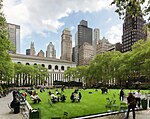Josephine Shaw Lowell Memorial Fountain
1912 establishments in New York City1912 sculpturesBronze sculptures in ManhattanBryant ParkFountains in New York City ... and 4 more
Granite sculptures in New York CityMonuments and memorials in ManhattanMonuments and memorials to womenOutdoor sculptures in Manhattan

The Josephine Shaw Lowell Memorial Fountain is an outdoor fountain in Bryant Park, Manhattan, New York memorializing Josephine Shaw Lowell, a social worker active in the late 19th century. The fountain was designed by architect Charles A. Platt and dedicated in 1912.
Excerpt from the Wikipedia article Josephine Shaw Lowell Memorial Fountain (License: CC BY-SA 3.0, Authors, Images).Josephine Shaw Lowell Memorial Fountain
West 40th Street, New York Manhattan
Geographical coordinates (GPS) Address Website Nearby Places Show on map
Geographical coordinates (GPS)
| Latitude | Longitude |
|---|---|
| N 40.75398 ° | E -73.98412 ° |
Address
Bryant Park
West 40th Street
10018 New York, Manhattan
New York, United States
Open on Google Maps









